The container-based firewall market is expected to grow from USD 265.9 million in 2025 to USD 584.8 million in 2035, advancing at a CAGR of 8.2%. A peak-to-trough analysis highlights how adoption cycles in container security evolve through rapid acceleration phases followed by relative stabilization. Enterprise cloud adoption rates, regulatory compliance pressure, and the continuous evolution of application architectures shape these cycles.
Between 2025 and 2029, the container-based firewall market is expected to reach its first peak. Demand will be accelerated by enterprises scaling up containerized workloads across hybrid and multi-cloud environments. Rising investments in Kubernetes and microservices architecture create immediate requirements for firewalls designed specifically to secure east-west traffic and inter-container communications. Financial services, healthcare, and government sectors drive peak adoption in this period due to heightened compliance needs, where regulatory frameworks mandate container-level segmentation and monitoring. The introduction of cloud-native security platforms integrated with container-based firewalls further enhances uptake during these years.
From 2029 to 2031, the container-based firewall market may experience a trough phase. During this period, enterprises that have already adopted container firewalls will slow additional procurement as systems stabilize and integration challenges are resolved. Replacement cycles extend as early deployments continue to provide sufficient security coverage, and demand growth temporarily moderates. Pricing competition among vendors also pressures revenue growth, while some organizations defer investments until next-generation firewall capabilities become widely available. This trough does not indicate demand collapse but reflects a natural stabilization phase common in maturing security technologies.
From 2031 to 2035, the container-based firewall market is projected to enter a second growth phase, with a renewed peak fueled by technological advances and expanding application scope. Integration of artificial intelligence for anomaly detection, deep packet inspection tailored for containers, and zero-trust policy frameworks revitalizes enterprise demand. Broader adoption of 5G, edge computing, and containerized workloads in telecom and manufacturing creates new opportunities where container-specific firewalls become essential. This period represents not only recovery from the prior trough but a strong upward shift as container firewalls become standard components of enterprise security stacks worldwide.
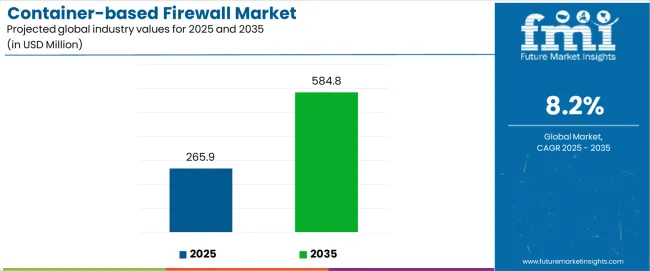
| Period | Primary Revenue Buckets | Share | Notes |
|---|---|---|---|
| Today | Cloud-based container firewalls | 56% | Scalable deployments, enterprise adoption |
| On-premises solutions | 44% | Legacy infrastructure, compliance requirements | |
| Advanced threat detection | 12% | ai-powered analytics, behavioral monitoring | |
| Future (3-5 yrs) | Hybrid cloud security platforms | 42-45% | Multi-cloud environments, unified management |
| Edge computing protection | 18-22% | IoT security, distributed architectures | |
| Financial services applications | 15-18% | Regulatory compliance, fraud prevention | |
| Healthcare security systems | 12-15% | Patient data protection, HIPAA compliance | |
| Manufacturing & industrial | 8-12% | OT security, critical infrastructure | |
| ai-powered threat intelligence | 6-10% | Machine learning, predictive analytics |
At-a-Glance Metrics
| Metric | Value |
|---|---|
| Market Value (2025) | USD 265.9 million |
| Market Forecast (2035) | USD 584.8 million |
| Growth Rate | 8.2% CAGR |
| Leading Deployment | Cloud-based Solutions |
| Primary Application | Financial Services Segment |
The container-based firewall market demonstrates strong fundamentals with cloud-based deployment systems capturing a dominant share through advanced scalability properties and enterprise application optimization. Financial services applications drive primary demand, supported by increasing regulatory requirements and cybersecurity modernization initiatives. Geographic expansion remains concentrated in developed markets with established technology infrastructure, while emerging economies show accelerating adoption rates driven by digital transformation initiatives and rising security standards.
Design for scalable security, not just protection
Primary Classification: The container-based firewall market segments by deployment type into cloud-based, on-premises, and hybrid, representing the evolution from traditional network security to sophisticated container-native protection solutions for comprehensive cybersecurity optimization.
Secondary Classification: Application segmentation divides the container-based firewall market into financial services, healthcare, manufacturing, retail, and others, reflecting distinct requirements for security performance, compliance standards, and threat protection specifications.
Tertiary Classification: End-use segmentation covers large enterprises, small-medium businesses, government agencies, cloud service providers, and managed security providers, while distribution channels span direct sales, security integrators, and specialized cybersecurity distributors.
Regional Classification: Geographic distribution covers North America, Latin America, Western Europe, Eastern Europe, East Asia, South Asia Pacific, and the Middle East & Africa, with developed markets leading adoption while emerging economies show accelerating growth patterns driven by digital transformation and cybersecurity modernization programs.
The segmentation structure reveals deployment progression from traditional on-premises firewalls toward sophisticated cloud-native security platforms with enhanced automation capabilities, while application diversity spans from financial institutions to manufacturing facilities requiring precision security solutions.
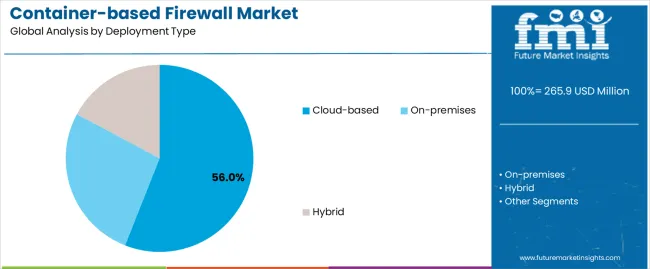
Market Position: Cloud-based firewall systems command the leading position in the container-based firewall market with 56% market share through proven scalability technologies, including elastic resource allocation, automated policy enforcement, and enterprise security optimization that enable organizations to achieve optimal threat protection across diverse cloud and hybrid environments.
Value Drivers: The segment benefits from enterprise preference for scalable security systems that provide automated threat detection, centralized management, and operational efficiency without requiring extensive on-premises infrastructure. Advanced cloud-native features enable enhanced threat intelligence, real-time monitoring, and integration with existing security platforms, where scalability performance and automated response represent critical operational requirements.
Competitive Advantages: Cloud-based firewall systems differentiate through proven scalability reliability, automated security features, and integration with established cloud platforms that enhance organizational effectiveness while maintaining optimal security standards suitable for diverse enterprise applications.
Key market characteristics:
On-premises firewall systems maintain a 44% market position in the container-based firewall market due to their compliance advantages and data sovereignty benefits. These deployments appeal to organizations requiring direct security control with enhanced regulatory compliance profiles for sensitive operations. Market growth is driven by financial services expansion, emphasizing regulatory compliance solutions and data protection through controlled security architectures.
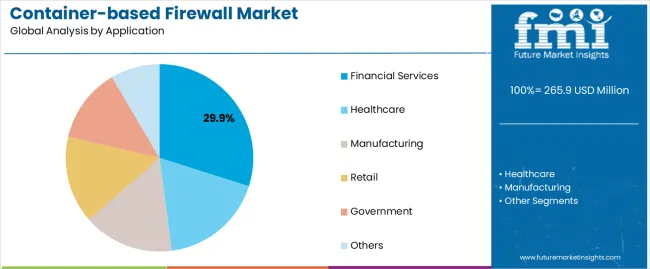
Market Context: Financial services applications demonstrate strong growth in the container-based firewall market with 9.2% CAGR and 29.9% industry share due to widespread adoption of advanced security programs and increasing focus on regulatory compliance, operational risk management, and fraud prevention applications that maximize security effectiveness while maintaining regulatory standards.
Appeal Factors: Financial institutions prioritize security reliability, regulatory compliance, and integration with existing financial infrastructure that enables coordinated security operations across multiple service channels. The segment benefits from substantial financial industry investment and regulatory modernization programs that emphasize the acquisition of advanced security solutions for threat protection and compliance applications.
Growth Drivers: Financial modernization programs incorporate container firewalls as essential components for digital banking operations, while fintech growth increases demand for security capabilities that comply with financial regulations and minimize operational risk.
Market Challenges: Varying regulatory requirements and compliance complexity may limit security standardization across different financial institutions or service scenarios.
Application dynamics include:
Healthcare applications capture 25% market share through specialized patient data protection requirements in hospitals, healthcare systems, and medical applications. These facilities demand advanced firewalls capable of supporting HIPAA compliance while providing data protection access and operational security capabilities.
Manufacturing applications account for 18% market share, including industrial facilities, smart factories, and operational technology requiring performance security capabilities for production optimization and industrial effectiveness.
Market Context: Large Enterprises dominate the container-based firewall market with 8.8% CAGR, reflecting the primary demand source for container-based firewall technology in enterprise security applications and infrastructure standardization.
Business Model Advantages: Large Enterprises provide direct market demand for comprehensive security systems, driving technology advancement and cost optimization while maintaining security control and compliance requirements.
Operational Benefits: Large Enterprise applications include security standardization, operational efficiency, and threat protection that drive consistent demand for firewall systems while providing access to latest security technologies.
| Category | Factor | Impact | Why It Matters |
|---|---|---|---|
| Driver | Digital transformation & cloud adoption (containerization, microservices, DevOps) | ★★★★★ | Growing cloud-native applications require specialized security solutions with enhanced threat protection capabilities and scalability properties proven effective across enterprise applications. |
| Driver | Cybersecurity threat evolution & advanced persistent threats (zero-day attacks, nation-state actors) | ★★★★★ | Transforms security requirements from "basic protection" to "advanced threat defense"; organizations that deploy intelligent firewalls and behavioral analytics gain competitive security advantage. |
| Driver | Regulatory compliance & data protection (GDPR, SOX, HIPAA compliance) | ★★★★☆ | Regulated industries need specialized, compliant security solutions; demand for certified and auditable firewall solutions expanding addressable compliance market. |
| Restraint | Implementation complexity & skill shortage (specialized expertise requirements) | ★★★★☆ | Smaller organizations defer advanced security upgrades; increases deployment complexity and slows premium firewall adoption in resource-constrained environments. |
| Restraint | Legacy infrastructure compatibility (existing security tools integration) | ★★★☆☆ | Traditional security solutions offer established vendor relationships and proven integration, potentially limiting container firewall adoption in conservative IT environments. |
| Trend | ai/ML security integration & automated threat response (behavioral analysis, predictive security) | ★★★★★ | Advanced analytics capabilities, automated incident response, and predictive threat detection transform operations; AI integration and intelligent automation become core value propositions. |
| Trend | Zero-trust architecture & micro-segmentation (identity-based security, least-privilege access) | ★★★★☆ | Granular security policies for specific applications and users; specialized zero-trust capabilities and targeted access controls drive competition toward precision security solutions. |
The container-based firewall market demonstrates varied regional dynamics with Growth Leaders including China (11.1% growth rate) and India (10.3% growth rate) driving expansion through digital transformation initiatives and cybersecurity infrastructure modernization. Steady Performers encompass Germany (9.4% growth rate), Brazil (8.6% growth rate), and developed regions, benefiting from established technology industries and enterprise security adoption. Mature Markets feature United States (7.8% growth rate), United Kingdom (7.0% growth rate), and Japan (6.2% growth rate), where cybersecurity advancement and compliance standardization requirements support consistent growth patterns.
Regional synthesis reveals East Asian markets leading adoption through digital transformation and cloud infrastructure development, while North American countries maintain steady expansion supported by security technology advancement and regulatory compliance requirements. European markets show strong growth driven by enterprise applications and GDPR compliance trends.
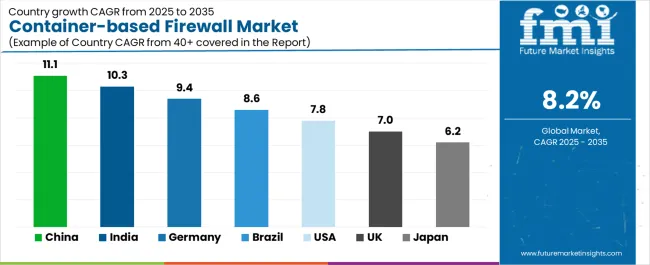
| Region/Country | 2025-2035 Growth | How to win | What to watch out |
|---|---|---|---|
| China | 11.1% | Focus on cloud-native security solutions | Regulatory changes; data localization |
| India | 10.3% | Lead with cost-effective enterprise solutions | Skill shortage; infrastructure limitations |
| Germany | 9.4% | Provide GDPR-compliant premium security | Over-regulation; lengthy compliance approvals |
| Brazil | 8.6% | Offer value-oriented cybersecurity solutions | Economic fluctuations; currency risks |
| United States | 7.8% | Push ai-powered security integration | Compliance costs; vendor consolidation |
| United Kingdom | 7.0% | Focus on financial services applications | Brexit impacts; regulatory changes |
| Japan | 6.2% | Emphasize precision manufacturing security | Traditional preferences; adoption rates |
China establishes fastest market growth through aggressive digital transformation programs and comprehensive cybersecurity infrastructure expansion, integrating advanced container firewall systems as standard components in cloud facilities and enterprise installations. The country's 11.1% growth rate reflects government initiatives promoting cybersecurity infrastructure and domestic security capabilities that mandate the use of advanced firewall systems in financial and technology facilities. Growth concentrates in major technology hubs, including Beijing, Shanghai, and Shenzhen, where digital infrastructure showcases integrated security systems that appeal to enterprises seeking threat protection optimization capabilities and compliance applications.
Chinese manufacturers are developing cost-effective security solutions that combine domestic innovation advantages with advanced threat detection features, including enhanced behavioral analysis and improved automation capabilities. Distribution channels through technology integrators and security distributors expand market access, while government support for cybersecurity development supports adoption across diverse enterprise and government segments.
Strategic Market Indicators:
In Mumbai, Delhi, and Bangalore, technology facilities and enterprise operators are implementing advanced container firewall systems as standard equipment for threat protection and compliance optimization applications, driven by increasing government digitalization investment and cybersecurity modernization programs that emphasize the importance of advanced security capabilities. The container-based firewall market holds a 10.3% growth rate, supported by government digital initiatives and technology development programs that promote advanced security systems for enterprise and government facilities. Indian operators are adopting firewall systems that provide consistent threat protection and compliance features, particularly appealing in urban regions where cybersecurity and operational excellence represent critical business requirements.
Market expansion benefits from growing technology capabilities and international partnerships that enable domestic production of advanced security systems for enterprise and government applications. Technology adoption follows patterns established in IT infrastructure, where reliability and security drive procurement decisions and operational deployment.
Market Intelligence Brief:
Germany's advanced technology market demonstrates sophisticated container firewall deployment with documented security effectiveness in enterprise applications and government facilities through integration with existing IT systems and operational infrastructure. The country leverages engineering expertise in cybersecurity and compliance systems integration to maintain a 9.4% growth rate. Technology centers, including Bavaria, Baden-Württemberg, and North Rhine-Westphalia, showcase premium installations where firewall systems integrate with comprehensive security platforms and facility management systems to optimize threat protection and operational effectiveness.
German manufacturers prioritize system quality and EU compliance in security development, creating demand for premium systems with advanced features, including GDPR integration and enterprise security systems. The container-based firewall market benefits from established technology infrastructure and a willingness to invest in advanced security technologies that provide long-term operational benefits and compliance with international cybersecurity standards.
Market Intelligence Brief:
Brazil's market expansion benefits from diverse enterprise demand, including digital transformation in São Paulo and Rio de Janeiro, technology facility upgrades, and government digitalization programs that increasingly incorporate advanced security solutions for enterprise applications. The country maintains an 8.6% growth rate, driven by rising technology activity and increasing recognition of advanced security benefits, including precise threat detection and enhanced operational effectiveness.
Market dynamics focus on cost-effective security solutions that balance threat protection performance with affordability considerations important to Brazilian enterprise operators. Growing digital industrialization creates continued demand for modern security systems in new technology infrastructure and facility modernization projects.
Strategic Market Considerations:
United States establishes market leadership through comprehensive cybersecurity programs and advanced technology infrastructure development, integrating container firewall systems across enterprise and government applications. The country's 7.8% growth rate reflects established technology industry relationships and mature security technology adoption that supports widespread use of advanced firewall systems in enterprise and government facilities. Growth concentrates in major technology centers, including California, New York, and Texas, where security technology showcases mature deployment that appeals to enterprise operators seeking proven threat protection capabilities and compliance applications.
American security providers leverage established distribution networks and comprehensive technical support capabilities, including deployment programs and training support that create customer relationships and operational advantages. The container-based firewall market benefits from mature regulatory standards and cybersecurity requirements that mandate firewall system use while supporting technology advancement and operational optimization.
Market Intelligence Brief:
United Kingdom's technology market demonstrates integrated container firewall deployment with documented security effectiveness in enterprise applications and government facilities through integration with existing IT systems and operational infrastructure. The country maintains a 7.0% growth rate, supported by cybersecurity excellence programs and threat protection requirements that promote advanced security systems for enterprise applications. Technology facilities across England, Scotland, and Wales showcase systematic installations where firewall systems integrate with comprehensive security platforms to optimize threat protection and operational outcomes.
UK technology providers prioritize system reliability and industry compatibility in security procurement, creating demand for validated systems with proven security features, including compliance monitoring integration and threat detection systems. The container-based firewall market benefits from established technology infrastructure and excellence requirements that support security technology adoption and operational effectiveness.
Market Intelligence Brief:
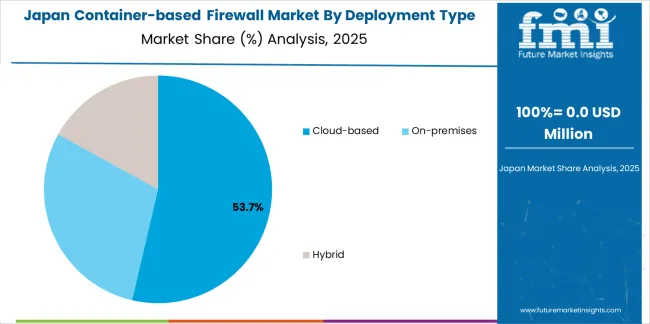
Japan's market growth benefits from precision technology demand, including advanced enterprise facilities in Tokyo and Osaka, quality integration, and operational enhancement programs that increasingly incorporate security solutions for threat protection applications. The country maintains a 6.2% growth rate, driven by cybersecurity technology advancement and increasing recognition of precision security benefits, including accurate threat detection and enhanced operational outcomes.
Market dynamics focus on high-precision security solutions that meet Japanese quality standards and threat protection requirements important to enterprise operators. Advanced technology adoption creates continued demand for sophisticated firewall systems in enterprise facility infrastructure and security modernization projects.
Strategic Market Considerations:
The European container-based firewall market is projected to grow from USD 58.4 million in 2025 to USD 128.7 million by 2035, registering a CAGR of 8.1% over the forecast period. Germany is expected to maintain its leadership position with a 41.3% market share in 2025, supported by its advanced technology infrastructure and major cybersecurity centers.
United Kingdom follows with a 26.8% share in 2025, driven by comprehensive financial services programs and cybersecurity excellence development initiatives. France holds a 16.4% share through specialized enterprise applications and GDPR compliance requirements. Italy commands a 9.7% share, while Spain accounts for 5.8% in 2025. The rest of Europe region is anticipated to gain momentum, expanding its collective share from 2.4% to 3.1% by 2035, attributed to increasing cybersecurity adoption in Nordic countries and emerging technology facilities implementing digital transformation programs.
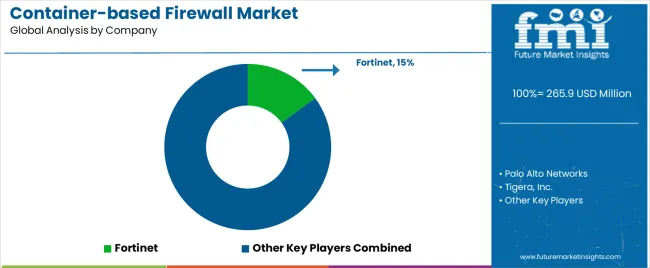
| Stakeholder | What they actually control | Typical strengths | Typical blind spots |
|---|---|---|---|
| Global security vendors | Market reach, comprehensive portfolios, brand recognition | Wide availability, proven security, multi-region support | Innovation cycles; customer dependency on legacy systems |
| Technology innovators | ai/ML R&D; advanced threat detection; next-gen security architectures | Latest technologies first; attractive ROI on security effectiveness | Service density outside core regions; scaling complexity |
| Regional specialists | Local compliance, fast deployment, nearby customer support | "Close to customer" support; pragmatic pricing; local regulations | Technology gaps; talent retention in cybersecurity |
| Cloud-native providers | Container expertise, DevOps integration, cloud platforms | Lowest operational friction; comprehensive cloud support | Service costs if overpromised; technology obsolescence |
| Niche specialists | Specific verticals, custom security, compliance services | Win premium applications; flexible configurations | Scalability limitations; narrow market focus |
| Item | Value |
|---|---|
| Quantitative Units | USD 265.9 million |
| Deployment Type | Cloud-based, On-premises, Hybrid |
| Application | Financial Services, Healthcare, Manufacturing, Retail, Others |
| End Use | Large Enterprises, Small-Medium Businesses, Government Agencies, Cloud Service Providers, Managed Security Providers |
| Regions Covered | North America, Latin America, Western Europe, Eastern Europe, East Asia, South Asia Pacific, Middle East & Africa |
| Countries Covered | China, India, Germany, Brazil, United States, United Kingdom, Japan, Canada, France, Australia, and 25+ additional countries |
| Key Companies Profiled | Fortinet, Palo Alto Networks, Tigera Inc., Juniper Networks, Aqua Security, Check Point Software Technologies, Alibaba Cloud, HUAWEI Technologies, Cisco Systems |
| Additional Attributes | Dollar sales by deployment type and application categories, regional adoption trends across East Asia, North America, and Western Europe, competitive landscape with cybersecurity vendors and technology providers, enterprise operator preferences for security effectiveness and threat protection, integration with security platforms and compliance management systems, innovations in ai-powered threat detection and automated response, and development of advanced security solutions with enhanced performance and operational optimization capabilities |
The global container-based firewall market is estimated to be valued at USD 265.9 million in 2025.
The market size for the container-based firewall market is projected to reach USD 584.8 million by 2035.
The container-based firewall market is expected to grow at a 8.2% CAGR between 2025 and 2035.
The key product types in container-based firewall market are cloud-based , on-premises and hybrid.
In terms of application, financial services segment to command 29.9% share in the container-based firewall market in 2025.






Our Research Products

The "Full Research Suite" delivers actionable market intel, deep dives on markets or technologies, so clients act faster, cut risk, and unlock growth.

The Leaderboard benchmarks and ranks top vendors, classifying them as Established Leaders, Leading Challengers, or Disruptors & Challengers.

Locates where complements amplify value and substitutes erode it, forecasting net impact by horizon

We deliver granular, decision-grade intel: market sizing, 5-year forecasts, pricing, adoption, usage, revenue, and operational KPIs—plus competitor tracking, regulation, and value chains—across 60 countries broadly.

Spot the shifts before they hit your P&L. We track inflection points, adoption curves, pricing moves, and ecosystem plays to show where demand is heading, why it is changing, and what to do next across high-growth markets and disruptive tech

Real-time reads of user behavior. We track shifting priorities, perceptions of today’s and next-gen services, and provider experience, then pace how fast tech moves from trial to adoption, blending buyer, consumer, and channel inputs with social signals (#WhySwitch, #UX).

Partner with our analyst team to build a custom report designed around your business priorities. From analysing market trends to assessing competitors or crafting bespoke datasets, we tailor insights to your needs.
Supplier Intelligence
Discovery & Profiling
Capacity & Footprint
Performance & Risk
Compliance & Governance
Commercial Readiness
Who Supplies Whom
Scorecards & Shortlists
Playbooks & Docs
Category Intelligence
Definition & Scope
Demand & Use Cases
Cost Drivers
Market Structure
Supply Chain Map
Trade & Policy
Operating Norms
Deliverables
Buyer Intelligence
Account Basics
Spend & Scope
Procurement Model
Vendor Requirements
Terms & Policies
Entry Strategy
Pain Points & Triggers
Outputs
Pricing Analysis
Benchmarks
Trends
Should-Cost
Indexation
Landed Cost
Commercial Terms
Deliverables
Brand Analysis
Positioning & Value Prop
Share & Presence
Customer Evidence
Go-to-Market
Digital & Reputation
Compliance & Trust
KPIs & Gaps
Outputs
Full Research Suite comprises of:
Market outlook & trends analysis
Interviews & case studies
Strategic recommendations
Vendor profiles & capabilities analysis
5-year forecasts
8 regions and 60+ country-level data splits
Market segment data splits
12 months of continuous data updates
DELIVERED AS:
PDF EXCEL ONLINE
Firewall as a Service Market
SMS Firewall Market Size and Share Forecast Outlook 2025 to 2035
Cloud Firewalls Market Size and Share Forecast Outlook 2025 to 2035
Next-Gen Firewall Market Size and Share Forecast Outlook 2025 to 2035
Industrial Firewall Device Market Size and Share Forecast Outlook 2025 to 2035
Network Security Firewalls Market Size and Share Forecast Outlook 2025 to 2035
Domain Name System (DNS) Firewall Market

Thank you!
You will receive an email from our Business Development Manager. Please be sure to check your SPAM/JUNK folder too.
Chat With
MaRIA